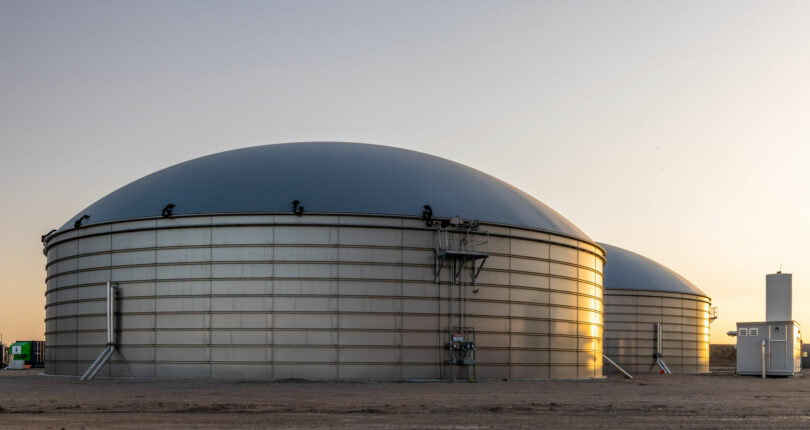Turning farm waste into renewable energy
Agricultural operations at the Kraft family farms in Morgan County produce alfalfa, corn, milk, manure, and as of this spring, renewable energy.
Husband and wife Chris and Mary Kraft and their son Stratton grow alfalfa and corn crops to feed some 4,500 black-and-white Holstein cattle at the family’s Quail Ridge Dairy near Fort Morgan. Those dairy cows produce about five semi loads of milk each day sold to make mozzarella cheese.

The new anaerobic digester at Six Arrows Dairy near Wiggins turns manure into energy. Photo by Val Loose.
However, those thousands of cows also produce a lot of waste — both liquids and solid manure — that must be constantly managed. At Quail Ridge Dairy, that animal waste adds up to roughly 140,000 gallons per day, Chris Kraft said.
This spring, after two years of construction, including some supply chain and weather delays, the Krafts are happy to see the completion of a facility that will turn that manure into energy. The waste will produce renewable natural gas through an anaerobic digester system built on 3 acres of their farm.
“In the dairy industry, we’ve committed to doing our part for the environment to reduce our greenhouse gas emissions,” Kraft said. “Producing milk is what we do; this is just the ability to take a system that’s already running and get gas off it.”
As manure decomposes naturally, about 60% of the biogas released is methane, a powerful climate-warming gas. However, if the manure is broken down with the use of bacteria in an enclosed digester without oxygen, the biogas can be purified into renewable natural gas.
Colorado State University Extension explains that anaerobic digestion can be used to decrease on-farm energy costs or increase revenues from energy sales. The gas from a digester can be used in a gas generator to produce electricity or to run gas boilers. Or, the gas can be purified and piped or trucked to a natural gas injection site.
The collection of methane from livestock manure can reduce global emissions of methane, reduce carbon dioxide emissions from fossil fuel use, diminish odor from agricultural facilities, and improve water quality, according to CSU Extension.
The Krafts opted to contract with Boston-based Vanguard Renewables, which has a partnership with Dairy Farmers of America. The farmers leased land to Vanguard that builds and operates the digester system while providing another revenue stream for the dairy.
The lease payments will not make farmers rich, by any measure, but every bit of financial assistance to keep family farms in Colorado viable is good news, Kraft said.
Darlene Steward, an environmental and energy systems researcher at the National Renewable Energy Laboratory in Golden, said farmers considering if a biogas digester would be a good fit should review the big picture of their farm operations — everything from use of manure to type of animal bedding.

Dairy farmer Chris Kraft, far right, leads a tour in May 2023 of the anaerobic digester under construction at his Quail
Ridge Dairy near Fort Morgan. Photo courtesy of Morgan County REA.
“You really have to take a holistic view of your entire operations, and it is really helpful to work with an expert,” Steward said. “It can be helpful to work with a biodigester turnkey company to evaluate the economic viability for your particular farm.”
Colorado State University Professor Sybil Sharvelle in civil and environmental engineering echoed the importance of working with a technology provider with a proven track record of success in the same climate region.
Quail Ridge Dairy was well-suited for the addition of a digester because the liquid waste and manure were already managed through a solid separator, Kraft said.
The solids were composted to produce fertilizer for hay fields and animal bedding. The liquids were stored in a lagoon for later use as fertilizer. With the new anaerobic digester, end products are still available, but the methane and much of the smell are removed, Kraft said. Sharvelle said interest in biogas digesters in Colorado has increased during the past five years due to favorable sustainableenergy policies in states such as California. These policies have increased the financial value of renewable natural gas.
“The price point of RNG is high enough currently that there is motivation to generate and capture as much methane as possible,” Sharvelle said. “There is a tremendous opportunity out here for us to turn manure waste into a valuable product.”
Reputable digester companies take the financial risk and technical headaches out of the process for farmers, Sharvelle said.
The collaborative AgSTAR program, sponsored by the U.S. Department of Agriculture and the Environmental Protection Agency, provides a good resource to learn about best practices through the Anaerobic Digester Project Development Handbook online at EPA.gov/agstar/ agstar-project-development-handbook.
AgSTAR notes that manure from dairy and swine operations can be best suited for farm-based energy conversion because those manure management systems are often liquid or slurry with central collection. Successful biogas systems thrive on economies of scale and typically operate with at least 500 cows or 2,000 hogs.
In 2023, AgSTAR reported 343 operational manure-based anaerobic digestion systems across the U.S., including 290 for dairy cattle, 46 for hogs, and others for poultry and beef. And the most recent data shows 86 digesters were under construction, including multiple in Colorado.
“I’m excited to see this level of traction and adoption of the technology,” Sharvelle said, “because it takes a problem and turns it into a resource.”
Suzie Romig is a degreed, award-winning journalist who lives near Steamboat Springs and has lived, worked, and explored in Colorado since 1990.

